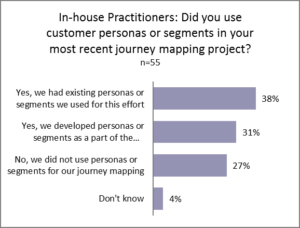
In my role as Heart of the Customer’s mapper-in-chief, I get the opportunity to view a lot of journey maps. Beautiful ones, ugly ones, those built to drive change, and those that are little more than gussied-up Excel spreadsheets.
But, as mentioned in our book, one thing that continues to surprise me is how few include personas. In our research a few years back, we found that nearly one-third of the CX practitioners surveyed didn’t include segments or personas in their work.
That’s a big mistake.
If you don’t identify and use personas in your journey maps, then you’re probably not designing experiences around specific types of customers – or even able to. Which means you’re probably designing to satisfy everyone and are therefore likely to create a ho-hum experience that isn’t optimized for anyone.
It’s like that old story: Half the party wanted iced tea and half wanted hot tea. So the host made both and mixed them to serve a lukewarm brew that disappointed everyone. But the best-case outcome there is even more cautionary: even if some guests didn’t mind drinking it, not one single person at that party got what they actually wanted or was delighted by the experience.
The fact is, “customers” are not some monolithic mass. They’re individuals with different wants, needs, and goals. So if you’re not using personas to capture and reflect those differences in your experience design, it’s likely that you’re missing important nuances…and lucrative opportunities.
Furthermore, focusing your design on your most important customers will make your customer experience efforts more effective, your initiatives more efficient, and your business more successful.
A persona is an archetype of a set of customers. Some organizations define their sets by demographics, but that standard can get you in trouble, because it only reflects superficial differences, not the distinctions that matter when it comes to customer thoughts, feelings, and decision-making. (Read our Meridian case study below for a clear example of how focusing solely on demographics would have led us astray.)
Similarly, many B2B companies seem confused about what a persona really is, and instead use job roles to define their persona sets. Now this might come as a surprise, but not all IT managers think alike! Or purchasers. Or insurance agents. You get the picture.
If you’re using job titles to identify and define your personas, you’re basing your success on generalities that are unlikely to matter, much less get you where you want to go.
The bottom line is that different people can experience the same journey differently, and it’s imperative that you understand why.
Best-in-class personas are defined by attitudinal and/or behavioral differences. That’s your starting point. Only once you discover how your customers vary by how they think, or what they do, can you look at demographics to help you identify them. But you it’s critical that you do it in that order, to make sure you’re focusing on the differences that truly matter.
With Heart of the Customer clients, we look for groups of customers with different Moments of Truth, as those critical interactions can help reveal a customer set. If one group is mostly focused on how the salesperson reacts to them, but another is more focused on a product performance, you’ve discovered real, actionable differences that need to be considered in your experience design.
You don’t need to start from scratch to create new personas as part of your journey mapping process. If you already have personas or segments, then by all means use them! (We found 38% of our survey respondents did just that.) Using persona definitions already known within your organization will make it easier to communicate the experience, and allow those redesigning the experience to leverage their familiarity.
In addition, there are some times when it doesn’t make sense to use personas for your journey mapping. For example, when we studied the Top Ten home builders, personas made no sense because our sample size was so small.
In our work, we often discover or refine personas in both B2B and B2C journeys while analyzing customer interviews during our immersive journey mapping process.
Customer experience is personal. Your design work (and the journey map it’s based on) needs to reflect that. Personas are the best way to bring individual customer needs to life.
 For competitive reasons, most of our clients can’t allow us to publish their personas. But one who does is Meridian Health, so we can discuss that here. (We also included their case study in our book, How Hard Is It to Be Your Customer?, as did Jim Kalbach, who published it in his book, Mapping Experiences.)
For competitive reasons, most of our clients can’t allow us to publish their personas. But one who does is Meridian Health, so we can discuss that here. (We also included their case study in our book, How Hard Is It to Be Your Customer?, as did Jim Kalbach, who published it in his book, Mapping Experiences.)
Meridian wanted to understand the points of friction in advanced radiology (MRIs, CT scans, and ultrasounds) from scheduling through getting test results. Someone starting with demographics probably would have selected two age-based personas for Meridian patients: Baby Boomers and Generation X patients.
Instead, we looked at attitudinal differences, and discovered three personas. The first, Newbie Natalie, did represent many Gen Xers. She’s new to this procedure, and as a result, she doesn’t know what to expect. So her needs are centered around clearer communication to set appropriate expectations and allow her to preview what’s ahead in her journey.
Next we discovered two separate Baby Boomer personas, each with its own distinct needs. Seen-It-All Stanley loves Meridian. He uses their health system for everything. As a result, he trusts the system, and his history within it gives him a good idea of what to expect. When something goes wrong, he trusts Meridian to make it right. His primary need is for reassurance that he’s made the right choice.
High-Maintenance Holly, in contrast, has high anxiety. She’s been through multiple doctors and hospitals, and her trust is low. She doesn’t believe any health system is on her side. The little bumps in the road that Stanley takes in stride rattle her. Even though she has more experience and knowledge than Natalie does, she still needs to have her expectations clearly set. Her anxiety makes her fragile and she forgets details. The small talk that Stanley enjoys drives her crazy – she needs her communication to be specific and substantive.
Imagine if Meridian tried to design an ideal experience using demographic-based personas – or, even worse, no personas at all! Stanley and Holly would have been lumped together, leading to the creation of an experience likely to be a miserable mishmash of mediocrity. And Meridian would have had no clear direction for how to move forward to improve their experience.
The best CX programs gain a firm understanding of their customer personas and their unique experiences along the journey first, and then design the experience to give each persona what they need at their unique Moments of Truth along the journey.
That’s how you create a customer experience that drives ROI.

